Latest news from Formentera and return trip with the pirates of Mac Orlan

I said goodbye to Formentera from the ferry not by throwing a bottle into the sea with a melancholic message like last year, which earned me complaints for polluting the oceans (I hope it wasn't because of my prose), but with a small libation of the island's herbal liqueur. And that's despite the fact that after reading Jules Verne's The Mysterious Island this holiday, I could argue that messages in bottles have saved lives, like that of Captain Grant or that of the feral boatswain Ayrton. I also thought about throwing my shiny new cap into the water, with the name Formentera and the island's coordinates (38°42'N 1°27'E) inscribed in a very salty way, thus imitating the gesture the British made when they left India and threw away their pith helmets. But I remembered how much the item had cost me at the Dossae store in Sant Francesc (an Es Cap model, 42 euros per brim, eco-friendly , of course), and I put it back on. In any case, the propitiatory gestures weren't out of place given that my trip coincided with the 25th anniversary of the sinking of the Kursk submarine , which is already a good time to set sail. I would have felt more reassured if I'd had a pendant made from the whiskers of a vell marí (the ancient, extinct seal of the Balearic Islands), the traditional Formentera amulet to avoid drowning.
After three long weeks on the island with hardly any news, these started to happen as soon as I started packing my suitcase, a long process that always takes me several days, as it includes collecting all the books and the thousand trinkets that I have not only brought but that I have been accumulating during these weeks of vacation, including various naturalist material such as feathers, shells, stones and even a new dormouse tail (which the rodent releases as a defense mechanism), without forgetting a beautiful drawing of Pelayo by Luke L. Carter, the author of Bar, a tour of the most authentic bars and beach bars of Formentera, and all the issues (7) of ADN, the comic magazine of the island purchased at the Tur Ferrer bookstore (unforgettable is the cover by Jordi Soldevila of the tourist disembarking in Formentera with her suitcase on wheels and wielding a katana like Kill Bill ).

The most exciting moment of the departure is when, in the early hours of the morning, I've loaded the old Suzuki Santana jeep I take with me every summer to the roof. I turn on the ignition, and because of the nighttime dew, it won't start, putting me in danger of missing the two consecutive trips I'm waiting for (Formentera-Ibiza and Ibiza-Barcelona). A real ordeal considering I've even prepaid the fare. This time, I ward off the threat by covering the engine with a blanket and putting another one on the hood as if my four-year-old Suzuki were a World War II SAS desert patrol vehicle. In fact, they charged me the hefty road tax on Formentera, as if I were driving David Stirling's own armored jeep. Anyway, I started off on the first try. Honestly, this year I could have had a plan B, since while diving off the Pelayo the day before I left, I didn't find a moray eel, a barracuda, a mermaid, or the legendary grunt or butterfly fish ( Dactylopterus volitan , a scorpionfish) that my daughter Berta, who's on a roll, saw, but rather the keys to a car! A rental Fiat. It's strange to come out of the water with your diving goggles in one hand and your car keys in the other: I looked like James Bond.
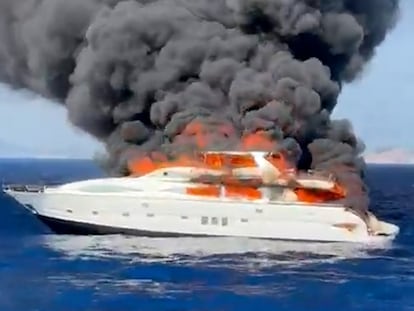
I was saying there's been a lot of news in recent days. More boats have arrived, exacerbating the humanitarian crisis that contrasts so sharply with the hedonistic atmosphere that rules the island in summer. A boat (the 28-meter-long Da Vinci yacht, near Es Vedrà, Ibiza) sank due to a fire, and the enormous column of black smoke could be seen from the Migjorn footbridge in front of the Vogamari as if Pearl Harbor had been unleashed on the horizon, all over again . A Formentera police dog trained to catch drugs (a female named Summer ) and on loan to the Ibiza police (as if she didn't have a job in Formentera) discovered a significant stash of pills and marijuana in Sant Josep (and no, it wasn't a Jack Russell terrier). Katy Perry has finally been fined €6,001 for filming a music video last summer in the protected area of s'Espalmador (it's true that with that amount of money you won't live long here if you go to certain restaurants). In the realm of the supernatural, the possible spectre recently observed at the Sílvias' house (S. Figarola and S. Komet), Ca na Cristos, in La Mola, would be sa iaia Cristos herself, Grandma Cristos, the original owner, known as such for being of very thin build reminiscent of the figure of the crucified Christ (own contribution based on the indispensable La toponímia de Formentera , by Vicent Ferrer i Mayans and Enric Ribes i Marí, Societat d'Onomàstica, 2023).
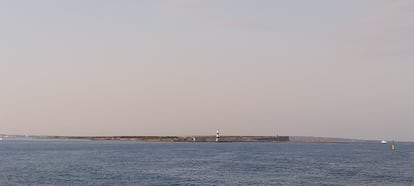
In any case, the news that shook the island cradled in the summer was the closure decreed by the Formentera Council of the Cala Duo restaurant (formerly Sa Sequi) for operating as a nightclub without a permit. The establishment, which Tony des Cans or Captain Nemo would hardly have visited, was far over the capacity limit—set at 50 people but exceeding a thousand at its peak—had furniture installed in public spaces that it had taken over and violated safety regulations. They were forced to remove awnings and parasols from the coastal area they had colonized, and the stereo system, apparently so powerful that some thought the seaplane base at the neighboring Estany Pudent had reopened, was sealed off. El Duo, which despite being located in a protected area of the Ses Salines Natural Park, continued the high-end, crowded party tradition of places like the original Beso and had become one of the island's must-see spots, was already the subject of controversy this summer due to videos on social media of roasted customers chanting insults at Prime Minister Pedro Sánchez. For its part, Cala Duo, which has been able to reopen in accordance with its authorized format, has considered the Consell's decision "disproportionate" and "lacking legal justification," while some frustrated users believe the establishment has been penalized simply for "stressing the seaweed ." Local media reported that Real Madrid footballers and wrestler Ilia Topuria have recently visited the establishment, which collects tips worthy of the Umayyad Caliphate. It's advisable not to get too cocky if you argue with a stranger on the beach because they've placed their umbrella too close.
But what has really hit us, lovers of buccaneer Formentera, "the Formentera that resists," as someone once called it, is the news that Ses Roques, the island's equivalent in fame to the vampire nightclub Titty Twister ( The Twisted Tit ) from From Dusk Till Dawn , the cult film by Robert Rodriguez and Quentin Tarantino, is closing. The venue at the entrance to Sant Ferran, identifiable by the smashed hippie van in the parking lot and the appearance that Salma Hayek is waiting for you inside as Satanic Pandemonium and below is an unknown Aztec temple, is about as different from Cala Duo as you can imagine. It's a wonderful dive with a ramshackle "magical" garden where you can dine, a space for outdoor performances, a bar full of conspirators, and an interior room that doubles as a disco and also as a stage (not forgetting an adjoining porch with a pool table, table football, and an unexpected library).
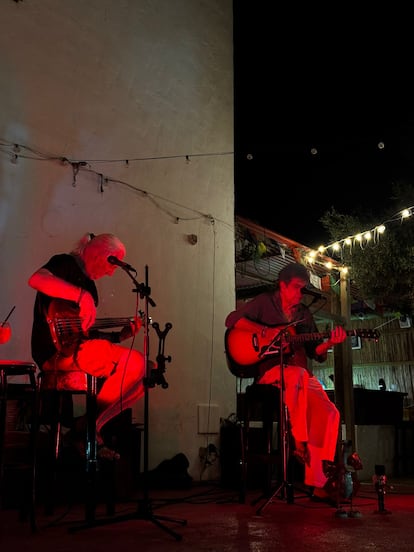
The soul of Ses Roques is its owner, Piero Ameli, an Italian musician and cultural promoter who arrived in Formentera in 1989, drawn by the island's long-standing connection with progressive rock and his own love of King Crimson and Pink Floyd (he covers a priceless version of "Wish You Were Here," which has become a true local anthem). Ameli leads a life full of surprises. Born in Alexandria—so it must be a lighthouse, Piero!—he is the co-writer of "Amante Bandido ," the song by Miguel Bosé. For eight years, he has been giving opportunities in Ses Roques to the island's musicians and those passing through—established and new talents, such as Anna Torre, Juanlu, Buty, Gatas voladoras—and each season he deploys a program that is eclectic to the point of madness. A stay in Formentera is not complete without listening to the Pink Floyd performance on its terrace, which he himself plays at the microphone with his broken voice and guitar, during which the old spirits that once inhabited these places seem to materialize.
Well, that is to say, bad: Piero has announced that Ses Roques is changing hands (in present-day Formentera, these things rarely improve), although he has left the door open to continuing his business in another location. In any case, this summer will be remembered, barring a miracle, as the end of two such emblematic places of that certain other Formentera as Ses Roques and El Pelayo . It was precisely El Pelayo that I strolled with heavy feet on the night of my departure, the car already loaded and my bike strapped to the bumper, to say goodbye. It was closed, and I left with the ghostly image of the beloved beach bar with its headlights dim and the moon bathing the palm-thatched roofs and shimmering on the sea like a melancholy silver farewell.
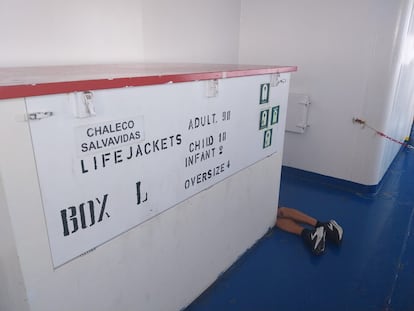
And the next day at noon I was already aboard the Transmed-GNV Sealand , heading for Barcelona, with the Suzuki in the hold and Charly fully ensconced in the cabin, nostalgically gazing from the deck at a flat, blue sea dotted with flying fish and dotted with the brown circles of a few jellyfish; although it's common knowledge that you shouldn't stare at the water flowing by, as that bothers the dead. I had with me my battered copy of Lord Jim— "it was one of those days when memories pile up in our minds, memories of other beaches, of other faces." But the reading I was especially saving for my return was The Anchor of Mercy by Pierre Mac Orlan (Alianza, 2025), the great writer of adventure literature, author of The Wharf of the Mists and The Song of the Crew, who curiously shares some traits with Piero Ameli, such as having been a songwriter (not to mention Piero's pataphysical corsair-wearing pirate-suede look and the fact that one of the wandering Italian's grandmothers was French). I'd been wanting to read this work by Mac Orlan (1882-1970) for some time, which has been so highly recommended by Fernando Savater , our own Nemo and Long John Silver. And I compulsively did so on the deck of the Sealand . It is true, as Fernando pointed out, that the 1946 novel owes much to Stevenson's Treasure Island , with a 16-year-old boy from Brest in 1777 obsessed with maritime adventures ("he was intoxicated by the wine of adventure that smells of gunpowder, iodine and unknown flowers"), Yves-Marie Morgat, Petit Morgat, involved in a murky story of friendship and piracy in which cider and crepes replace rum and apples. I would modestly add the influence of Dickens's Great Expectations , with that prisoner who determines the boy's fate, Jean de la Sorgue.
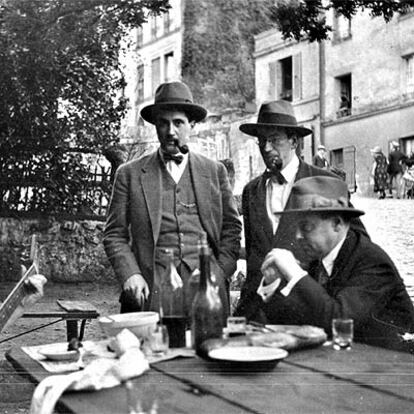
Oddly enough, most of the first-person story takes place on land (the protagonist only makes one voyage to Ushant on a fishing boat towards the end of the adventure, when he stumbles upon a confusing naval battle). The title refers to the name of Petit Morgat's father's nautical supply store (a shop that serves as the Admiral Benbow Inn), and metaphorically to the last moral grasp of an evil man. Despite its land-based setting, the book is full of the scent of the sea, from the presence in the port of the beautiful schooner Rose of Savannah —with a figurehead of a topless black girl— and its dark promise of adventure, to the constant threat of the dangerous, omnipresent but invisible pirate Nicolas Trupet, alias Petit-Radet , and the spyglass purchased by the mysterious, taciturn naval surgeon, interested in the natural sciences (did Patrick O'Brian draw inspiration from this for Stephen Maturin?). Burns then strikes up a precious friendship with the protagonist and his Rousseaun-esque father, and sets the boy's imagination (and mine on the Sealand) soaring with his evocations: “I have sailed all the waters that a frigate can carry. I have seen marvelous cities, brighter and more beautifully painted than the tapestries of Shiraz. I have seen pearls cascading down the drain and drunk tea from cups softer and more transparent than rose petals.”

Yet Burns is elusive and melancholic, as if living in the shadow of a scaffold: “And yet, of all this, all that remains in my memory is a bitterness that often disturbs my sleep.” And he asserts that adventure is only beautiful in books, “a dangerous mirage,” a dream, and that the important thing is to live with courage and dignity, earning the esteem of all who approach you. “I have sought adventure in all the seas of the world, and I have never found it as beautiful and pure as I imagined it to be; it is never attained,” I read, as if Mac Orlan were whispering in my ear against the backdrop of the Sealand PA system announcing that the ferry’s self-service car service remained open. “You spend the best part of your life trying to reach a poetic phantasm. And then you get old, and you feel like you are slowly dying, ignoring everything that should constitute the true joy of living… a home, a loved one.”
And in these, across the wide sea, we arrived at port.
EL PAÍS




%3Aformat(jpg)%3Aquality(99)%3Awatermark(f.elconfidencial.com%2Ffile%2Fbae%2Feea%2Ffde%2Fbaeeeafde1b3229287b0c008f7602058.png%2C0%2C275%2C1)%2Ff.elconfidencial.com%2Foriginal%2F26e%2F7bd%2Fd37%2F26e7bdd37269e6439b3d1760e8ca5901.jpg&w=3840&q=100)